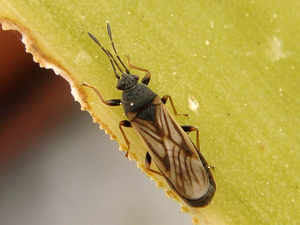Lean bugs
| Lean bugs | ||||||||||||
|---|---|---|---|---|---|---|---|---|---|---|---|---|

Fully winged imago of Ischnodemus sabuleti |
||||||||||||
| Systematics | ||||||||||||
|
||||||||||||
| Scientific name | ||||||||||||
| Blissidae | ||||||||||||
| Stål , 1862 |
Narrow bugs (Blissidae) are a family of bugs (Heteroptera). Until the revision of the Pentatomomorpha with a focus on the Lygaeoidea by Henry in 1997, it was a subfamily of the ground bugs (Lygaeidae) and was then placed in the family rank. It comprises 50 genera and around 435 species. In Europe 10 species are represented, two of which occur in Central Europe.
features
The family includes a wide range of species of different sizes. This ranges from short and strongly built species to those that are long and slender. The body is covered with fine thorns. The spiracles of the abdomen are almost all dorsal , only the seventh is on the ventral side . In the male, the body segment with the genitals has a tubercle, the sperm reservoir has wing-like appendages. The olfactory gland openings on the abdomen of the nymphs lie between the fourth and fifth, as well as the fifth and sixth tergum . The hemielytres are not or only weakly structured in punctiform fashion. It is not uncommon for brachyptere individuals to appear whose wings are shortened. In some species, only brachyptic animals exist. Often the hemielytres have regressed to only short, scale-like residues.
distribution and habitat
The family is common worldwide, but is absent in New Zealand. It has its main distribution center in the tropics. The regions with the greatest number of endemics are found in southern Africa and Madagascar, in the Oriental and the tropical parts of Central and South America, with endemic genera occurring mainly in the Neotropic . 36 of the 50 described genera each contain only five or fewer species; 19 genera of which are monotypical . All of these small genera have a relatively small distribution. Only the genus Ischnodemus is distributed almost worldwide (with a focus on the tropics).
Way of life
The bugs live mainly on monocotyledons . They do this often hidden in the basal gap between the leaf sheath and the stalk. Unlike most of the other species of Lygaeoidea, which suckle on seeds in a granular manner, the small bugs instead suckle on the vegetative parts of the plants. They are predominantly monophagous , so they only feed on a certain type of plant or suckle on a few, closely related species. The majority of the species live on sweet grasses (Poaceae), a few on sour grass plants (Cyperaceae) and Restionaceae . However, there are also individual records of species in the ginger family (Zingiberales), rush family (Juncaceae), lily family (Liliales), cattail family (Typhaceae) and hedgehog (Sparganiaceae). A number of species occur as pests on grasses (especially barley , maize , millet , oats , rye , sorghum and wheat , but also on grasses for sugar and alcohol production, lawns and forage). Here in particular polyphagous species are of great economic importance.
Taxonomy and systematics
Carl Stål described the taxon in 1862 as a taxon above the genus range as "Blissida". Slater defined the monophyly of the group and left the rank of a subfamily within the ground bugs (Lygaeidae). After a revision of the Pentatomomorpha with a focus on the Lygaeoidea by Henry in 1997, the subfamily Blissinae including the Slaterellinae was placed in the family rank. It is in his view in a sister relationship to a taxon that includes the Lygaeidae , Piesmatidae , Cryptorhamphidae , Cymidae , Ninidae , Malcidae , Colobathristidae and Berytidae .
The family is divided into two subfamilies:
- Subfamily Blissinae
- Subfamily Slaterellinae
The following genera and species are common in Europe:
- Genus Blissus
- Blissus putoni Jakovlev , 1875
- Genus Dimorphopterus
- Dimorphopterus blissoides ( Baerensprung , 1859)
- Dimorphopterus brachypterus ( Rambur , 1839)
- Dimorphopterus doriae ( Ferrari , 1874)
- Dimorphopterus spinolae ( Signoret , 1857)
- Genus Ischnodemus
- Ischnodemus caspius Jakovlev , 1871
- Ischnodemus genei ( Spinola , 1837)
- Ischnodemus quadratus fever , 1837
- Ischnodemus sabuleti ( Fallen , 1826)
- Ischnodemus suturalis Horvath , 1883
supporting documents
Individual evidence
- ^ A b c T. J. Henry: Phylogenetic analysis of family groups within the infraorder Pentatomomorpha (Hemiptera: Heteroptera), with emphasis on the Lygaeoidea. Annals of the Entomological Society of America 90 (3): 275-301, 1997.
- ↑ a b c d e Family Blissidae. Australian Biological Resources Study. Australian Faunal Directory, accessed January 4, 2014 .
- ↑ a b Blissinae. Fauna Europaea, accessed January 4, 2014 .
- ↑ a b Ekkehard Wachmann , Albert Melber, Jürgen Deckert: Bugs. Volume 3: Pentatomomorpha I: Aradoidea (bark bugs), Lygaeoidea (ground bugs, etc.), Pyrrhocoroidea (fire bugs) and Coreoidea (edge bugs, etc.). (= The animal world of Germany and the adjacent parts of the sea according to their characteristics and their way of life . 78th part). Goecke & Evers, Keltern 2007, ISBN 978-3-937783-29-1 , p. 72 f .
- ↑ a b R. T. Schuh, JA Slater: True Bugs of the World (Hemiptera: Heteroptera). Classification and Natural History. Cornell University Press, Ithaca, New York, 1995, pp. 255f.
literature
- RT Schuh, JA Slater: True Bugs of the World (Hemiptera: Heteroptera). Classification and Natural History. Cornell University Press, Ithaca, New York, 1995.